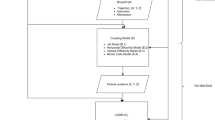The characteristics of hot particles in the ambient environment are presented: activity, propagation, size, and density as well as contribution to the total activity of contaminants, distribution factor, leach rate, and deposition rate. The differences of suspensions, bottom deposits, and hot particles are shown. The equations governing the transport of radionuclides are formulated for systems, consisting of hot particles and suspensions, in water and bottom deposits. The coefficients in the equations are determined and the possibility of radionuclides being removed from bays by tides is taken into account. Solutions are obtained for the transport equations and the average sizes of the activity spots owing to hot particles and ordinary suspensions are determined. The possibility of transport of hot particles over large distances in a river floodplain is examined. The water circulation rate at which hot particles are carried out of flooded objects is determined.
Similar content being viewed by others
References
Radioactive Particles in the Environment: Sources, Particle Characterization and Analytical Techniques, TECDOC-1663, IAEA, Vienna (2011).
Yu. A. Izrael’ (ed.), Chernobyl: Radioactive Contamination of the Environment, Gidroatomizdat, Leningrad (1990).
A. Ya. Bolsunovsky and V. O. Tchkerzian, “Hot particles in the Enisei River floodplain, Russia,” J. Envir. Radioact., 57, No. 3, 167–174 (2001).
Z. V. Gritchenko, Yu. V. Kuznetsov, V. K. Legin, et al., “Hot particles of the second kind in the Enisei floodplain soil,” Radiokhim., 43, No. 6, 563–565 (2001).
D. G. Matishov and G. G. Matishov, Radiation Ecological Oceanology, Apatity (2001).
F. Wagenpfeil and J. Tscheirsch, “Resuspension of coarse fuel particles in the Chernobyl area,” J. Envir. Radioact., 57, No. 1, 5–16 (2001).
V. Zheltonozhsky and K. Muck, “Classification of hot particles from Chernobyl accident and nuclear weapon detonation,” J. Envir. Radioact., No. 2, 151–156.
V. A. Kashparov, Evaluation and Prediction of Radioecological Conditions in Radiation Accidents with Discharge of Particles of Irradiated Nuclear Fuel for the Example of the Accident at the Chernobyl NPP: Dissert. Doct. Biol. Sci., Ukrainian Institute of Radiobiology (1999).
A. V. Konoplev and A. A. Bulgakov, “Transformation of 90Sr and 137Cs forms present in soil and bottom deposits,” At. Energ., 88, No. 1, 51–60 (2000).
Yu. A. Platovskikh and I. V. Sergeev, “Radionuclide transport in bays after a radiation accident,” At. Energ., 97, No. 1, 74–78 (2004).
Ts. E. Mirtskhulava, Foundations of the Physics and Mechanics of Riverbed Erosion, Gidrometeoizdat, Leningrad (1988).
Yu. V. Sivintsev, S. M. Vakulovskii, A. P. Vasil’ev, et al., Technogenic Radionuclides in Seas Laving Russia, IzdAT, Moscow (2005).
V. A. Danilyan, V. L. Vysotskii, A. A. Maksimov, and Yu. V. Sivintsev, “Impact of salvaging of nuclear submarines on the radioecological conditions in the Far East region,” At. Energ., 89, No. 6, 455–474 (2000).
Yu. A. Platovskikh, “Analysis of radioactive contamination of bays and inlets on the Kola Peninsula, Novaya Zemlya, and the Far East,” At. Energ., 103, No. 4, 263–270 (2007).
D. S. Grishin, N. L. Kuchin, A. I. Laikin, and Yu. A. Platovskikh, “Problems of evaluating the radioecological situation from results of in situ measurements,” Podvod. Tekhnol. Mir Okeana, No. 5–6, 76–83 (2006).
J. Smith, K. Ellis, and K. Naes, “Sedimentation and mixing rates of radionuclides in the Barents Sea sediments of Novaya Zemlya,” Deep-Sea Res. II, 62, No. 8, 1471–1493 (1995).
M. N. Ganul, N. L. Kuchin, Yu. A. Platovskikh, and I. V. Sergeev, “Modeling of radioactive contamination of bays after a radiation accident,” Deep-Sea Res. II, 92, No. 5, 380–387 (2002).
N. L. Kuchin, A. I. Laikin, and Yu. A. Platovskikh, “Relation between the dynamics of radionuclide emission from submerged objects and radionuclide distribution in bottom deposits,” At. Energ., 115, No. 6, 335–340 (2013).
Yu. A. Platovskikh, I. V. Sergeev, and Yu. V. Kushenov, “Mathematical modeling and analysis of the behavior of radionuclides in the system Krasnoyarsk Mining and Chemical Combine – Enisei – Kara Sea,” At. Energ., 95, No. 6, 457–466 (2003).
Author information
Authors and Affiliations
Additional information
Translated from Atomnaya Énergiya, Vol. 122, No. 4, pp. 230–234, April, 2017.
Rights and permissions
About this article
Cite this article
Kuchin, N.L., Laikin, A.I. & Platovskikh, Y.A. Hot Particles and Radionuclide Transport in Water Media. At Energy 122, 278–283 (2017). https://doi.org/10.1007/s10512-017-0267-3
Received:
Published:
Issue Date:
DOI: https://doi.org/10.1007/s10512-017-0267-3




